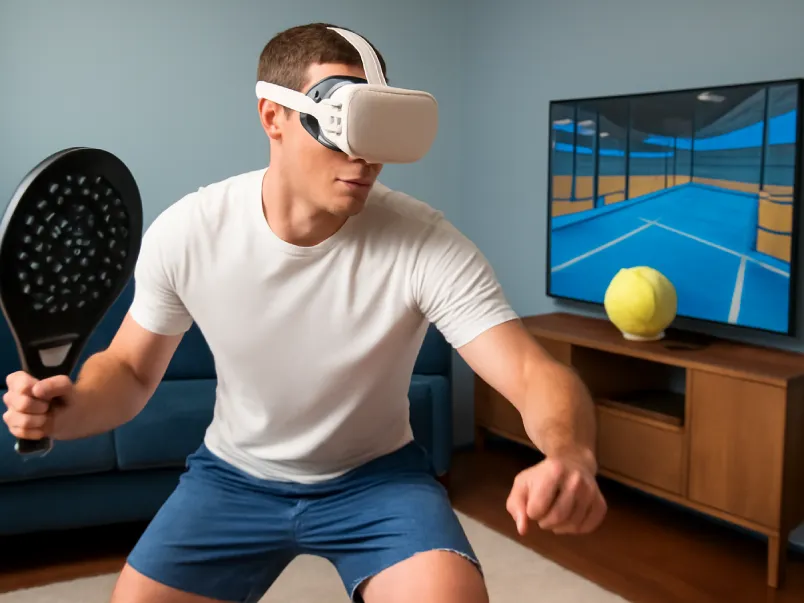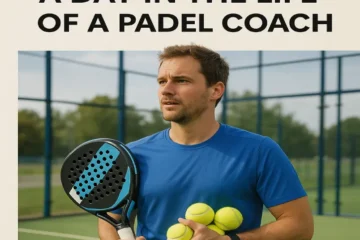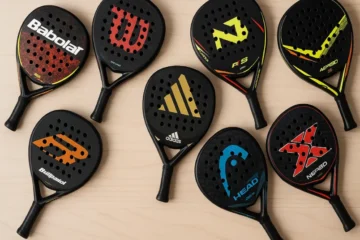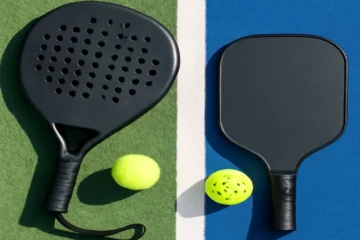The Future of Padel Training is Here
Padel is one of the fastest-growing sports worldwide, attracting players of all ages and skill levels. Its mix of tennis and squash, combined with its fun and fast-paced nature, has made it a favorite in both casual and competitive settings. However, there’s one major challenge all padel enthusiasts face: finding enough court time and a reliable training partner. With busy schedules and limited access to courts, it’s often difficult to practice as frequently as one would like.
Fortunately, the advent of Virtual Reality (VR) has opened up new possibilities for training. Whether you’re an aspiring pro or a casual player, VR provides an innovative solution to improving your padel game from the comfort of your own home. Can VR truly enhance padel training? Yes – and in this article, we will explore the best VR games for padel and how you can integrate them into your real-world training regimen.
Why Train Padel in VR? The Unexpected Benefits
While virtual reality is commonly associated with gaming, it offers much more than just a fun distraction. For athletes, VR can be an effective training tool, and padel is no exception. But why exactly should you consider incorporating VR into your training routine? Here are some key benefits:
- Unlimited Repetition: One of the greatest advantages of training in VR is the ability to practice specific shots over and over again without the need to chase balls. For padel players, this means you can repeatedly practice complex shots like bandejas or viboras until you get them just right, all without any physical effort beyond your swing.
- Improved Reaction Time & Decision Making: Padel is a fast-paced sport that requires quick thinking and even faster reflexes. VR simulates these real-time scenarios, forcing players to make decisions on the fly. The more you train in a VR environment, the sharper your decision-making skills become, translating into faster reactions on the real court.
- Spatial Awareness & Court Positioning: Padel requires a keen understanding of court positioning and angles. VR gives you a chance to simulate court dynamics, teaching you to read virtual angles and understand where to stand in various situations. You can work on refining your positioning, which is often a challenge for beginners and intermediate players alike.
- Off-Season & Bad Weather Training: During the off-season or on days when the weather isn’t ideal for outdoor sports, VR provides a convenient way to maintain your training. Instead of letting your skills stagnate, you can keep practicing, staying sharp even when you can’t access a real court.
- Accessibility & Affordability: One of the barriers to playing padel is the cost of court time and equipment. VR training eliminates those costs, making it a more affordable way to stay engaged with the sport. A VR headset is a one-time investment that gives you the freedom to train as much as you want, without worrying about expensive court bookings or traveling.
However, it’s essential to understand that VR isn’t a perfect substitute for actual court play. While VR can improve mental and reactive skills, it cannot replicate physical mechanics, footwork pressure, or the tactile sensation of hitting a real ball. It’s best seen as a supplement to, not a replacement for, physical training.
Top VR Padel Games for Serious Training
Now that we’ve established why VR is a valuable tool for padel training, let’s dive into some of the top VR games that can help you hone your skills.
A. Game 1: VR Padel – Multiplayer Sports Game
Platforms: Meta Quest 2/3/Pro, SteamVR, and more.
If you’re looking for a realistic and immersive VR padel experience, VR Padel – Multiplayer Sports Game stands out as one of the best options available. This game is the closest you can get to playing on an actual court in VR.
Key Training Features:
- Realistic Physics and Court Dimensions: The game’s attention to detail makes it feel as close to real padel as possible. You’ll experience the accurate physics of the ball’s movement, court dimensions, and even the sound of the ball hitting the walls.
- Single-player AI Mode: Whether you’re a beginner or an advanced player, you can practice against AI opponents that adjust to your skill level.
- Multiplayer Mode: Challenge friends or join matches with players around the world. This feature helps you practice your reactions and strategies against human opponents, making the training more dynamic and unpredictable.
- Training Modes: VR Padel offers specific drills, such as serve training and target practice, so you can focus on perfecting particular shots.
Best For: This game is ideal for players who want the most complete and realistic padel experience in VR. It’s great for all levels of play, from beginners learning the fundamentals to advanced players working on their shot precision.
B. Game 2: Eleven Table Tennis (Padel Mode)
Platforms: Meta Quest, SteamVR.
Though not explicitly designed for padel, Eleven Table Tennis offers an excellent padel training experience thanks to its highly realistic physics and focus on racket control. Several mods or settings within the game allow for a padel-specific training experience.
Key Training Features:
- Accurate Racket and Ball Physics: While the game is focused on table tennis, the ball physics and racket mechanics closely mirror those of padel, especially regarding wrist movement and ball control.
- Focus on Reaction Time: The fast pace of this game helps you improve your reflexes and timing, two crucial skills in padel.
- Multiplayer: Engage in competitive games with others to further develop your skills.
Best For: This game is perfect for players focused on improving their volleys, wrist movement, and reaction time. While it’s not specifically made for padel, it still offers valuable benefits for refining the technical aspects of your game.
C. Game 3: Racket Club
Platforms: Meta Quest and others.
Racket Club is a unique game that blends elements of padel, tennis, and squash. It stands out for its innovative approach to training by focusing on strategic play and understanding court angles.
Key Training Features:
- 360-Degree Court: One of the most unique features of Racket Club is the 360-degree court. This mirrors the strategic nature of padel, where positioning and angles are crucial to success. The game encourages players to read the court and adjust their positioning based on the ball’s trajectory.
- Wall Play & Anticipation: A key aspect of padel is using the walls to your advantage. Racket Club incorporates wall-play mechanics, making it an excellent tool for practicing this vital skill.
- Slower Pace: The game’s slower pace encourages strategic thinking, which aligns well with the tactical aspects of padel.
Best For: Players looking to develop tactical intelligence, understand angles, and improve their anticipation. It’s also a great way to learn how to use the walls effectively – a crucial skill in padel.
How to Integrate VR into Your Real-World Padel Training
While VR is an excellent training tool, it’s important to use it effectively to see real improvements in your game. Here’s how you can integrate VR training into your existing padel regimen:
- Focus on Intent: Don’t just mindlessly swing your racket in VR. Each shot should have purpose and intent. Choose specific drills or challenges that target the areas of your game you want to improve, such as footwork, reaction time, or shot accuracy.
- Watch the Ball (Racket): Just like in real-life training, you need to watch your racket during each shot to understand its angle and trajectory. Pay attention to the ball’s behavior after hitting it – this can give you clues about your technique.
- Incorporate Footwork: While VR can’t replicate physical footwork pressures, it’s important to practice proper footwork in your virtual training. Incorporate split-steps, lateral movements, and quick pivots to mimic what you would do on an actual court.
- Use it as a Warm-Up: VR is a great way to mentally prepare for a real match. A quick 15-minute VR session before heading to the club can help you sharpen your reactions and get in the zone for real-life play.
- Analyze Your Gameplay: Many VR games offer replays of your matches. Watch these to identify areas for improvement. Look for mistakes in your positioning or poor shot selection that you can correct next time.
Getting Started: What You Need to Play
To begin training in VR, you’ll need the right hardware:
- Essential Hardware: A standalone VR headset, like the Meta Quest 2 or 3, is highly recommended due to its ease of use and portability.
- Adequate Play Space: To move freely in VR, ensure you have a play space of at least 6.5 x 6.5 feet.
Recommended Accessories:
- Silicone Face Cover: This helps with hygiene, especially if you’re using your VR headset frequently.
- Comfortable Head Strap: For longer sessions, a more comfortable head strap can make a big difference in preventing neck strain.
- VR Racket Attachment: For a more immersive experience, consider a VR racket attachment. It adds weight and allows you to physically swing something, enhancing realism.
Conclusion: Level Up Your Game, Virtually
Virtual reality is reshaping how we approach training in sports, including padel. While it may never replace the thrill and physicality of playing on an actual court, VR offers an exciting, accessible, and effective way to sharpen your skills. With the right games and training techniques, you can improve your reaction time, decision-making, spatial awareness, and more—all from the comfort of your home.
Incorporating VR into your training routine could give you a distinct edge over your competition, making it easier to stay sharp between real-world sessions. So, why not level up your game virtually? The future of padel training is already here!
FAQs
1. Can VR help improve my padel skills?
Yes! VR can significantly improve your reaction time, decision-making, spatial awareness, and court positioning, which are all crucial elements of padel. It’s especially beneficial for practicing specific shots and maintaining your skills when you can’t access a physical court.
2. What are the best VR games for padel training?
Some of the top VR games for padel training include VR Padel – Multiplayer Sports Game, Eleven Table Tennis (with padel mods), and Racket Club. Each offers unique features such as realistic physics, training modes, and multiplayer capabilities that help players refine their skills.
3. Is VR padel training suitable for all skill levels?
Yes, VR padel training is suitable for players of all levels. Whether you’re a beginner learning basic shots or an advanced player working on strategy and reaction time, VR provides tools that cater to your needs.
4. Do I need a high-end VR headset for training?
No, while high-end VR headsets like Meta Quest 3 offer the best performance, even more affordable models like Meta Quest 2 can provide a great training experience. Just ensure your headset is compatible with the games you’re interested in.
5. How can I integrate VR into my regular padel training?
You can use VR as a warm-up or cool-down before heading to the real court, or as a supplement during the off-season or bad weather. Focus on intentional shot selection, proper footwork, and analyzing your gameplay to make your virtual training effective.
6. Can VR replace real padel practice?
While VR training is an excellent supplement to real-world practice, it cannot fully replace physical court play. VR helps improve mental and reactive skills, but it can’t replicate physical mechanics, footwork pressure, or the tactile feel of hitting a real ball.




